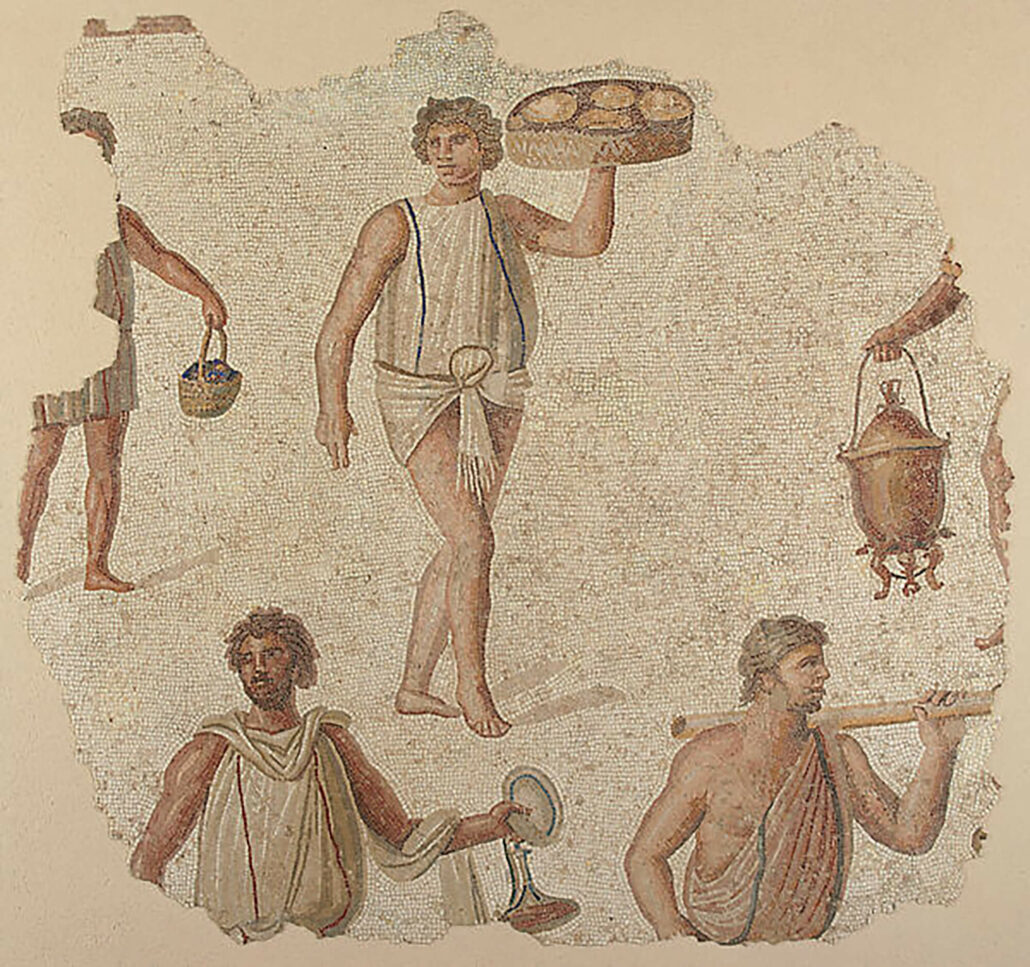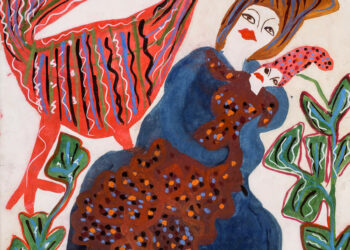‘Africa & Byzantium’ will feature nearly 200 artworks, including many that have never before been exhibited in the United States

Mosaic Panel of Preparations for a Feast, Tunisia, Carthage, late 2nd century CE. Marble, limestone, molten glass, 94 1/2 x 88 5/8 in. (240 x 225 cm). Paris, Musée du Louvre, Department of Greek, Roman, and Etruscan Antiquities (MNC 1577; Ma1796). © RMN-Grand Palais / Art Resource, NY. Photo: Hervé Lewandowski
The Metropolitan Museum of Art will present ‘Africa & Byzantium’, a seminal exhibition of nearly 200 works that will explore the tradition of Byzantine art and culture in North and East Africa from the 4th through the 15th century and beyond.
On view from November 19, 2023, through March 3, 2024, ‘Africa & Byzantium’ will shed light on an underrepresented area of art history and showcase a burgeoning new field of interdisciplinary scholarship on medieval Africa. Even though Byzantium was a vast empire that spanned parts of Africa, Europe, and Asia, its extensive connections to Africa have previously been understudied. Bringing together art, religion, literature, history, and archaeology, this innovative exhibition will highlight artworks from the multicultural communities of northern and eastern Africa.
The exhibition focuses on the art from the centuries when much of North Africa was ruled by the Byzantine Empire from its capital in Constantinople and when early Christianity developed in kingdoms on the horn of Africa (the fourth to the seventh century CE). It also addresses the distinctive religious and artistic traditions that flourished in Tunisia, Egypt, Sudan, and Ethiopia (the 8th to the 15th century CE). Faith, politics, and commerce across land and sea linked these traditions to Byzantium, resulting in a lively interchange of arts and beliefs. Objects in the exhibition span almost two thousand years with a range of media, from monumental frescoes, mosaics, panel paintings, and metalwork, to jewellery, ceramics, and illuminated manuscripts.
This exhibition is made possible by the Ford Foundation, The Giorgi Family Foundation, and Mary Jaharis. Major support is provided by the National Endowment for the Humanities: Democracy demands wisdom.* Additional support is provided by an Anonymous Foundation, the Michel David-Weill Fund, The International Council of The Metropolitan Museum of Art, The Visiting Committee for the Department of Medieval Art and The Cloisters, and the National Endowment for the Arts. The exhibition is organised by The Metropolitan Museum of Art and The Cleveland Museum of Art.
“This stunning exhibition brings new focus and scholarship to an understudied field, expanding our knowledge of Byzantine and Early Christian Art within an expansive worldview,” said Max Hollein, The Met’s Marina Kellen French Director and CEO. “Through spectacular and widely unknown works of art, ‘Africa & Byzantium’ illuminates the development, continuity, and adaptation of Byzantine art and culture in North Africa and the Horn of Africa, recentering African artistic contributions to the pre-modern period.”
Andrea Achi, Mary and Michael Jaharis Associate Curator of Byzantine Art at The Met, said: “Africa & Byzantium builds upon the long legacy of The Met’s award-winning Byzantine exhibitions. Bringing together new research from over forty scholars worldwide, the exhibition addresses how diverse communities connected to Byzantium flourished in African empires and kingdoms for over a thousand years. It will broaden public understanding of the Byzantine world, its reach, and transcultural authority and examine the critical role of early African Christian civilizations in this creative sphere.”
The exhibition will foreground the critical role played by early African Christianity and its heritage, traditions, and history in the Byzantine world, while challenging common preconceptions about the arts of both Africa and Byzantium. In presenting Africa as central to the world of late antique and Byzantine worlds, the exhibition considers the global impact of ideas and arts made in northern and eastern Africa.
Exhibition Overview
‘Africa & Byzantium‘ traces three artistic arcs. From the fourth to the seventh century, early Byzantine visual and intellectual culture was shaped by wealthy patrons, artists, and religious leaders in northern Africa. From the eighth century to the sixteenth century, distinctive Christian religious and artistic traditions flourished in African Kingdoms, and finally, from the seventeenth century to the twentieth century, Ethiopian and Coptic artists in eastern Africa found inspiration in Roman and Byzantine Art. The vibrant and inspiring art displayed throughout the exhibition will culminate with a trio of contemporary works, which bring alive themes of translation, circulation, and memory, raising critical questions about where and when Byzantium “ends.”
Africa in Late Antiquity
Northern Africa included some of the wealthiest provinces of the late Roman/early Byzantine empire. The remarkable objects in this section demonstrate the wealth and status of diverse communities between the Mediterranean and the Red Sea and give powerful expression to their values and systems of belief. The objects explore how different multi-faith cultural influences were adapted to unique regional tastes, including Christian aesthetics, Greek traditions, and the under-explored connections between Judaism and Byzantium. This section will feature early Byzantine Icons from the Holy Monastery of Saint Catherine’s at Sinai; virtuosically carved ivories from late antique Nubia; gold, amethyst, and pearl jewellery from Alexandria, Egypt; and exquisite, richly coloured limestones and marble mosaics from Tunisian museums, traveling to the United States for the first time.
“Bright as the Sun”: Africa after Byzantium
The second part of the exhibition reveals the ways in which northern and eastern African artists used imagery to interact with different identities, such as the continued development and expansion of the distinctive local forms of Christianity and Christian art in the region. The anchor of this section will be monumental medieval Nubian wall paintings. Medieval Nubians moved in multiple cultural worlds; in addition to their indigenous language, many of the elites were fluent in Greek, Coptic (Egyptian), and, later, Arabic. Nubian material and visual culture were equally complex. The exhibition will feature representations of Nubian bishops and dignitaries from the Great Cathedral of Faras, which is currently submerged in the Nile. Other highlights will be rarely seen loans from the Holy Monastery of Saint Catherine’s at Sinai, exceptional Coptic manuscripts and icons, and Ethiopian icons that juxtapose artistic styles from the Mediterranean, Western Europe, and Eastern Africa. The section reflects on systems of periodisation and explores the questions: where and when does Byzantium end?
Legacies
This section addresses Byzantium’s continued legacy in Africa and explores the ways in which artists of African descent continue to find inspiration in Roman and Byzantine traditions. The re-translations and memories of Byzantine art continue to resonate from the medieval period to today. Legacies features contemporary artworks that reflect on and connect to earlier traditions. Contemporary artists, including Tsedaye Makonnen and Theo Eshetu, engage with the past and challenge how historical and environmental changes complicate the interpretation of medieval arts and architecture in the region. Above all, the exhibition intends to challenge the conventional understanding of the separateness of Byzantium and Africa and to launch the next generation of scholarship on the intertwined worlds of Byzantine and African art.
The exhibition will be on view from the 19th of November, 2023, until the 3rd of March, 2024. The exhibition will be featured on The Met website as well as on social media.



